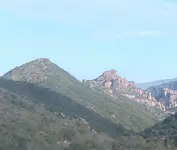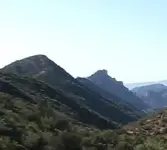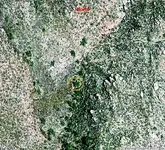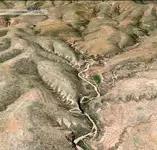Cactusjumper wrote
Roy,
Just curious.....Have you ever read of the many prospectors, treasure hunters and relic hunters that used the abandoned missions as their base of operations until the park service took over the locations? There were old mines all over those areas. The prospectors may very well have worked the old dumps. In those times, any return would have been welcomed. Perhaps they added some bulk to some modest slag heaps.
Why no, Joe, I have never read anything whatsoever in the last thirty years of prospecting and treasure hunting. I might ask you the same question - for quite a few of those early American prospectors,
told of finding old Jesuit mine workings, like the Salero.
THE SALERO MINES
About three miles south from the Alto are antiguas also, wrought by the Jesuits long, long ago; and it was one of the first to which attention was turned after American occupation sixty years ago, there clustering about it traditions of some of the tragedies of Apache hate ferocity. Until recent years it was in operation, a steady producer high grade lead and silver ores but the death of the chief owners following each other closely some years ago caused suspension of operations and the property stands idle.
<from
University of Arizona Bulletin, County Resource Series No.1, Santa Cruz County, Allen T. Bird, 1916, pp 23>
There were old mines all over those areas, and yet
no record of any Spaniards having worked them; on the other hand, we have the stories from the Indians whom lived there, that those old and often well hidden mines, had been worked by the padres. As to adding bulk to "Modest" slag heaps, this does not address the slag built into the churches, not to mention that some of the first people to SEE those slag heaps, stated there were HUGE TREES growing on top of them. How do you account for that - fast growing Thujas maybe?
I no longer am trying to change your views on this topic Joe in case you were thinking that was my reason to post, a pretty clear case has been presented in spite of a number of attempts to derail the topic early on; the question was whether the stories of Jesuit treasures (and by extension, the mines which helped amass those treasures) are true, and we have NOT had to resort to any "unknown" Spanish or Anglo miners or prospectors to explain things. Neither have we had to come up with any unknown persons whom were casting bells at the missions, nor actually using the resulting slag to literally decorate the walls. It is a pretty clear picture.
On the other hand, the counter-argument, trying to dismiss everything, has been a hodge-podge of POSSIBLE other explanations, like the mercury used to amalgamate gold, which is exactly what father Och stated that he did with the mercury and yet you were throwing everything against that proverbial wall hoping something MIGHT stick to explain that one away. It does not matter to me how many modern historians "believe" that the Jesuits were mining and smelting or not, just as it has not mattered to you that we have cited the American Geographical Society, the Royal Geographic Society, governors of Arizona, the USGS geologists, the official report submitted by Lieutenant Sylvester Mowry, West Point grad and US Boundary Commissioner, the letter of bishop Palafox, the statements of father Segesser about his living in the "silver mountains" and clearly implying there was an abundance of silver yet had only few silver eating utensils, among numerous others. I do not know, nor really care, why there has been a modern revisionist effort to erase this period of Jesuit activities, but neither will I be silent about it. I still would like to see some answers to the questions posted earlier.
Let me try to point this up - if you were researching about the campaigns of Alexander the Great, whom would you think would have the most accurate information -
A: a modern historian who wrote a book a few years ago,
B: one whom lived two centuries after Alexander, or
C: one that lived and wrote shortly after Alexander died?
It is the same case with this issue of Jesuit mines and treasures;
modern historians mostly deny it, but virtually all of the historians and sources
closer to the actual events, including some from the Jesuits themselves, state it as a matter of fact.
Cactusjumper also wrote
sailaway,
It's a story of pure fiction that all of the Jesuits notes, manuscripts and documents were destroyed. You are just looking in the wrong places. The big secret is that, there is no secret. Loose quote from Ben Franklin.
Right, and I might point out that we have more readers than active posters here Joe, people to whom you cannot lend a book too handily, which might enjoy reading some of those temporal records from the missions on the frontiers. BTW the Mission 2000 database is a pretty good resource, the way you sort of "
sneer" at anything online really amazes me sometimes. There are resources available online, which are not available in books, including rare and old books which otherwise we might not be able to obtain even though they have been published at one time. Can you pull up a book from your excellent library, and see the census records or research newspaper archives, for examples? Do you have copies of the Congressional Record, which is not completely online but some excellent and interesting portions are (so far)?
Thank you for the offer to lend that book BTW, but no need; if I decide to get a copy I can find one.
Cactusjumper also wrote
deducer,
I have ruled out.......NO ONE!. You, as well as others, have ruled out everyone.....except the Jesuits.
NO ONE is ruled out? So you include some mystery American miners as quite possibly the men whom were
CASTING BELLS at Guevavi and Tumacacori? Sorry Joe but there is a chain of evidence there, the eyewitness reports of those who saw the slag piles, evidence of casting in the form of a bell mould and a partly cast bell, slag which almost undeniably had to come from smelting ORE, a string of SILVER mines which were found with plenty of evidence they had been worked a long time before and many hidden, and the only people whom actually lived in the area continuously, did not say it was some Spaniards or Americans but the padres. You really think it is SO ridiculous to conclude that the Indians were telling the truth?
Roy













